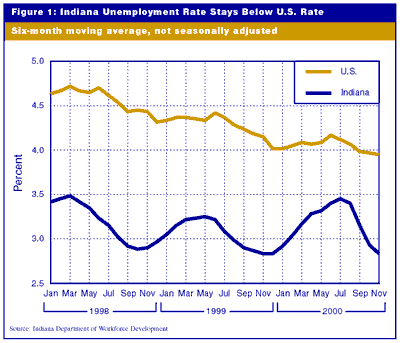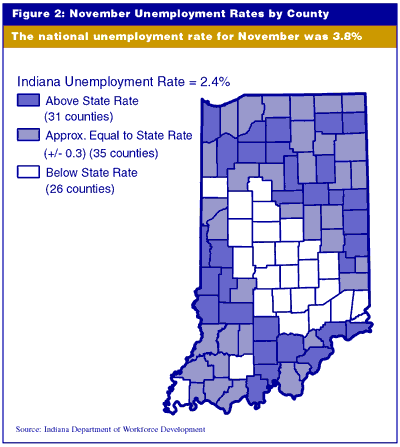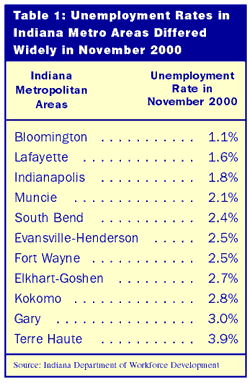Local Unemployment Rates Spread over Wide Range
The unemployment rate in Indiana has been at very low levels for more than two years. According to figures released recently by the Indiana Department of Workforce Development, the statewide rate in November was 2.4%. The comparable rate for the entire nation was 3.8%.
The chart in Figure 1 shows the long-term trend since the beginning of 1998. Indiana's unemployment rate and the comparable U.S. non-seasonally adjusted rate are tracked as six-month moving averages. Although the U.S. rate declined steadily over the two-year period, Indiana's rate was always lower.

Indiana's neighboring states also generally post higher numbers than Indiana. The November monthly unemployment rate was 4.1% in Illinois, 3.6% in Kentucky, 3.3% in Michigan and 3.7% in Ohio. In fact, Indiana's November monthly unemployment rate of 2.4% was the seventh-lowest in the nation. The only states with a lower unemployment rate than Indiana in November were Connecticut (1.6%), New Hampshire (1.9%), Virginia (2.0%), South Dakota (2.2%), Iowa (2.3%) and Massachusetts (2.3%).
That low 2.4% rate, however, is not found consistently across Indiana. Rates in individual Indiana counties ranged from a low of 1.0% in Hamilton County to 5.6% in Perry County (see Figure 2).
Click on map to see larger version with data.

Metropolitan areas differed widely, too (see Table 1). In November, the unemployment rate in greater Indianapolis was only 1.8%. That's well below the average rate for the state as a whole. Indianapolis is much larger than any other metro area in the state, though. So as the table shows, in order for the state average to have been 2.4%, most other metro areas had rates higher than the state average. Terre Haute came in with the highest November rate for Indiana metro areas, at 3.9%.

County and metro area unemployment rates are calculated by the Department of Workforce Development, Labor Market Information division, for the Bureau of Labor Statistics, U.S. Department of Labor, using sophisticated estimation models. The models use Indiana data from a national household sample, other key state unemployment indicators and the historical average relationship between the local area and the state.
